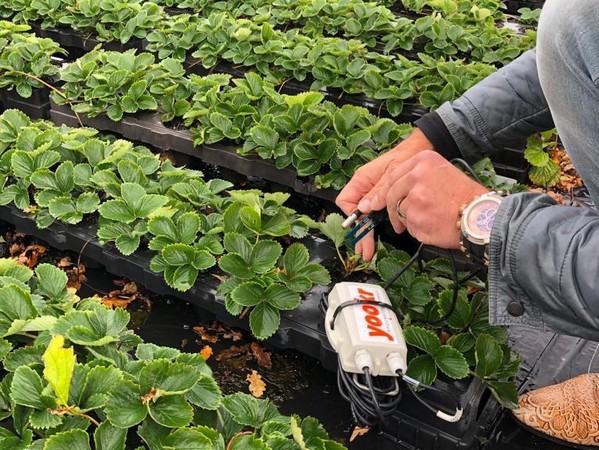European companies and knowledge institutes are working on a biosensor, which growers can use to measure their fruit and vegetables' vitamin content. The research is part of the Interreg project Food Screening EMR. Here, smart sensor technology is being (further) developed. It must detect food's vitamin content quickly, simply, and cheaply during the production process. This update is from Brightlands Campus Greenport Venlo, in the Netherlands.
This on-site measurement technology offers fruit and vegetable farmers the chance to steer a sustainable, stable vitamin increase in their crops. They get to use state-of-the-art cultivation methods for this. This project also investigates how you can use sensor technology to substantiate claims about products' nutritional value and health benefits.
The universities: the biosensor
Maastricht University (the Netherlands) has teamed up with the Aachen University of Applied Sciences (Germany) and the Universities of Liège and Hasselt (Belgium). They will be working on the biosensor. The technology was initially developed for detecting illegal drugs in urine or powders of unknown origin. That is according to Kasper Eersels. "We'll modify the sensor and use it to detect, for example, vitamin C in fruits and vegetables," says the assistant professor of Sensor Engineering at Maastricht University.
You can already measure vitamin content in a laboratory. But it is quite expensive for growers to submit samples from each batch of crops to an external lab for nutritional analysis. So the current practice is to weigh the product. Growers then consult a table and estimate how much vitamin C per gram, say, a carrot typically contains. That value appears on the packaging.
"It's simply too expensive to specifically determine ingredients to market your products. But an inexpensive sensor could be the solution. Growers could routinely use this to determine these values themselves. Not only for health claims but also to innovate cultivation processes."
"For example, you could analyze two spinach growing techniques. And quickly check whether a new method increases, for example, the plants' folate content. We want to adjust this sensor to integrate it into a dipstick and a portable sensor. Then growers can use them in greenhouses or their fields," explains Eersels.
Each university brings its field of expertise to the project. "Developing sensor technology is a complex process. By working together, you make clever use of each other's knowledge. We're good at receptors. Sensors need those to detect a specific substance in, say, fruit juice. Hasselt and Liège are working on a 'converter'."
"The receptor binds the substance you want to detect. The sensor must also detect that this has happened, hence the 'convertor'. It is up to Aachen to bring all this together in a handy device. It sounds cliché, but together you truly are more than the sum of your parts," says Eersels.
Software developers: the data
The Dutch start-up Yookr and Zumolab in Germany are going to develop this new biosensor's software. The sensor will be rolling out plenty of information. This must reach the end-user in a useful way. According to John van Helden of Yookr, this biosensor could simplify food producers' lives. "You can measure how rich, for example, your tomatoes or carrots are in vitamins. On the spot. You can monitor this in real-time and, if needed, adjust the production process."
He says there is no problem with the technology that collects and 'reads' the data. The biggest challenge is to ensure the biosensor can do stable, reliable measurements under different conditions. "We know from experience that, for example, heat always affects readings. The lab must ensure they have the correct sensor material. They must add a read-out chip that collects the measurement information. Then we can get to work with the software. And visualize the data in a good way," he says.
Sensors are truly the future, according to Van Helden. "Consumers are increasingly aware of how important healthy, safe food is. This biosensor means you can quickly and cheaply measure your product's vitamin levels. That can benefit growers."

Knowledge center: the claims
The next step is to integrate the biosensor's readings and the data. That must be added to legal nutrition and health claims. These must convince people of a product's added value. "Health claims are now mainly based on theory," says Alie de Boer, food scientist and head of the Food Claims Centre Venlo, a Maastricht University department.
"And they're generalized. There's no distinction between the different fruit and vegetable varieties. This biosensor will help gain insight into a specific product's nutritional value. We want to see how we can use the measurements' information to make health claims."
De Boer says this will help growers. They can see what their products contain. And they will be able to adjust their product accordingly. For instance, by growing a particular type of tomato with lots of vitamin C or B1. Or by breeding for specific characteristics. Farmers can then market their product with a clear message.
But this is also a significant development for consumers. According to the food scientist, "Shoppers increasing want to know what's in products. This awareness isn't hype; it will continue. If growers can provide insight into all the good things in their products, they're already ahead of the game."
Financing
The European Union's Interreg program Euregio Meuse-Rhine will be contributing to the Food Screening EMR project. This program was created to address problems in border regions. It also promotes cross-border cooperation within Europe.
Source: Brightlands
